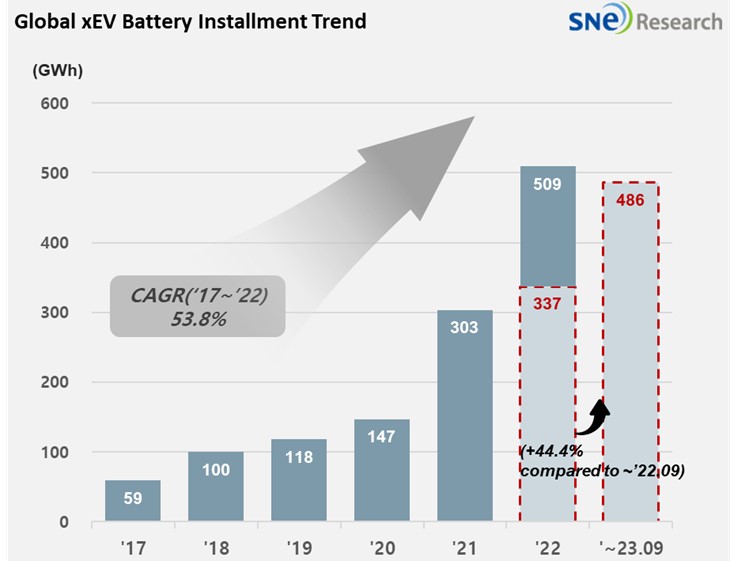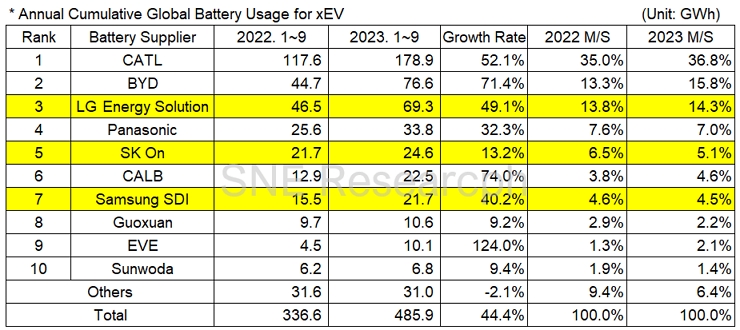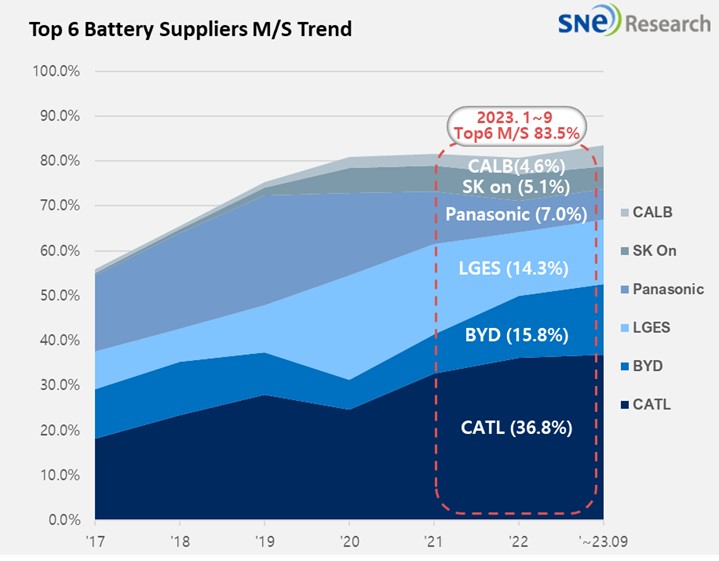From Jan to Sep in 2023, Global[1] EV Battery Usage[2] Posted 485.9GWh[3], a 44.4% YoY Growth
- From Jan to Sep in 2023, K-trio’s M/S recorded 23.8%
From
January to September 2023, the amount of energy held by batteries for electric
vehicles (EV, PHEV, HEV) registered worldwide was
approximately 485.9GWh, a 44.4%
YoY growth.

(Source: 2023
Oct. Global Monthly EV and Battery Monthly Tracker, SNE Research)
The combined market shares of K-trio companies were 23.8%, declined by 1.1%p compared to the same period of last year, but all of them remained in an upward trend in terms of battery usage. LG Energy Solution ranked 3rd on the list, posting 49.1%(69.3GWh) YoY growth, while SK On took the 5th place with a 13.2%(24.6GWh) growth and Samsung SDI ranked 7th with a 40.2%(21.7GWh) growth.

(Source: 2023
Oct. Global Monthly EV and Battery Monthly Tracker, SNE Research)
The growth trend of K-trio was
mainly affected by strong sales of electric vehicle models equipped with
batteries of each company. Samsung
SDI continued with its growth momentum based
on the increasing sales of BMW i4/i7 and Audi Q8 e-Tron as well as a decent
sales of Rivian R1T/R1S/EDV and FIAT 500. SK On posted a growth thanks to solid
sales of Hyundai IONIQ 5, KIA EV6, and Mercedes EQA/B. Recently, as it has been
reported that SK On reached a decent level of accomplishment in developing
prismatic and LFP battery, which is highly sought after in the market, the
company is expected to see a growth in its market share especially focusing on
the North American region. LG Energy Solution recorded
the highest growth among K-trio companies, driven by favorable sales of Tesla
Model 3/Y, VW ID. series, and Ford Mustang Mach-E that are highly popular in
Europe and North America. GM, continuously witnessing a slowdown in sales,
is reported to have a plan to expand its EV line-up and production volume in
earnest, based on battery produced by Ultium Cells, a joint venture with LG
Energy Solution. As GM is going to launch electric vehicles such as Blazer EV sold
at affordable prices, it is expected to be leading the growth of LG Energy
Solution.
Panasonic, the only Japanese company in the top 10 on the list, recorded 33.8GWh, a 32.3% YoY growth. Panasonic, who is one of the major battery suppliers to Tesla, has most of its battery usage installed in Tesla models in the North American market. Even though it made an announcement of decrease in it battery cell production last September, Tesla Model Y of which sales rapidly soared compared to the same period of last year has driven the growth of Panasonic.
CATL posted a 52.1%(178.9GWh) YoY growth, making it as the only battery supplier in the world to account for more than 30% of the global market share and thus remaining as top on the list. Particularly, CATL, who has been expanding its presence from the domestic market to overseas ones, showed a growth almost doubled from the same period of last year in every continent except China. CATL’s battery is installed in major passenger EV models in the Chinese domestic market such as GAC Group’s Aion Y and Geely’s ZEEKR 001 as well as in vehicles made by global major OEMs such as Tesla Model 3/Y, BMW iX, and Mercedes EQS. As its battery is widely used in a variety of vehicle models, CATL has continuously seen a high growth.
BYD witnessed a high growth compared to the same period of last year based on its high popularity in the Chinese domestic market. BYD is known for its price competitiveness through vertical SCM integration such as in-house battery supply and vehicle manufacturing. It exhibited a 71.4%(76.6GWh) YoY growth. Recently, it has been rapidly expanding its market share in other regions than China mainly with its Atto 3(Yuan plus) model.

(Source: 2023
Oct. Global Monthly EV and Battery Monthly Tracker, SNE Research)
There have been rising issues in the EV and battery market that the EV sales started to see a slowdown in growth and the price competitiveness has become more important than the performance of EV itself. In line with this trend, several battery makers turned their eyes to LFP battery of which price competitiveness is higher than ternary battery. The Korean battery makers, who have been focusing on high-Ni battery, recently released their battery roadmap for L(M)FP and high-voltage mid-Ni. While Chinese companies, who have strength in LFP battery technology and production, have difficulties in directly entering the overseas markets due to heightened trade barriers in many countries (e.g., the Inflation Reduction Act in the US), attentions should be drawn to changes in global market shares according to LFP battery strategies carried out by the Korean battery trios.
[1] The xEV sales of 80 countries are
aggregated.
[2] Based on battery installation for xEV
registered during the relevant period.
[3] (From Jan 2022 ~ Sep 2023) Downward adjustment by taking the export volume of some Chinese companies from the Chinese domestic amount

